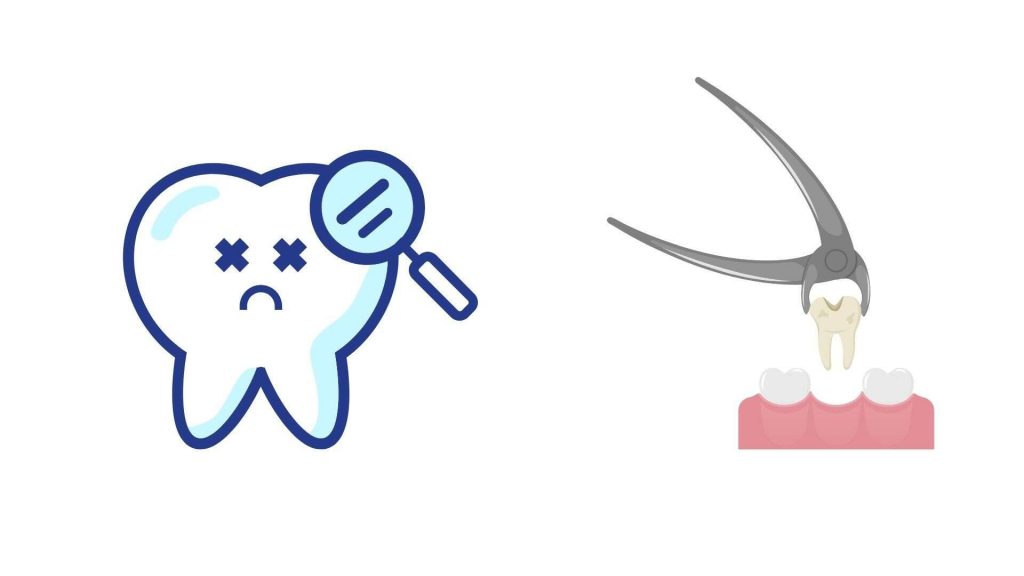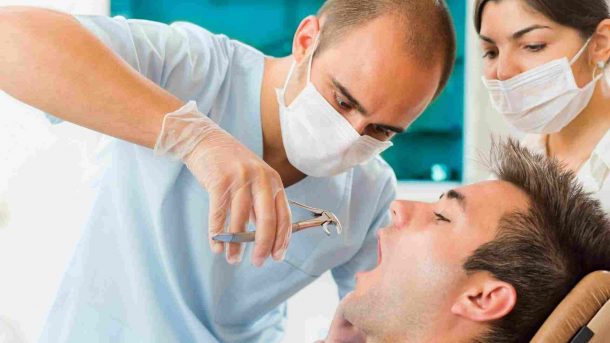After Tooth Removal
When a tooth is removed, an empty space remains. A prosthetic dental implant can be used to replace the natural tooth root. Learn all about implants and what they can do, who should have one and how it is done, the procedure to get one, cost of a dental implant and how long does it last.
[lwptoc]
The loss of an anterior tooth can have a profound impact on your smile. With today’s advanced materials and surgical techniques, missing teeth can be restored more fully, quickly, and with greater results than ever before.

Demonstrates Dentalvibe for Painfree Injections
Dentalvibe is a single-use device designed to be used with an automatic dental injection unit. It is intended for use by patients who are in need of analgesia before receiving a dental injection procedure, but cannot afford prescription medications. The treatment time is set according to the machine and the intensity level is adjusted by the patient’s body weight. The device™s stimulation is painless and absolutely drug free.
The sensory nerves in the mouth vibrate and block the pain signals from reaching the brain. Dentalvibe does not interfere with any of your existing teeth, or any dental restorations, dentures or body parts. You do not need to do anything special before treatment and it has no adverse side effects such as dizziness or feeling sick or nauseous .
The Dentalvibe is a non-invasive, drug free device that provides ultrasound energy to the area of the tooth. This treatment interrupts pain signals before they reach the brain and suppresses elevated levels of inflammatory cytokines which are responsible for most post surgical pain.
The Dentalvibe promotes healing and accelerates regeneration of injured jawbone which protects against unwanted dental implants. Finally, it allows clinicians to administer local anesthetics into the area of surgery with less chances of bleeding or tissue injury.
Dentalvibe™ is a wearable natural frequency healing device that has a proven track record in helping to reduce your pain within 1-2 hours of being used. This North & South America patented (US 7915223 B2) product is the first of its kind. It uses ancient wisdom of sound pitch and vibration to help heal the body and mind. After tooth extraction the traditional post-procedure care is usually a Vicodine prescription, muscle relaxer, and homeopathic medication. This common treatment can be supplemented with Dentalvibe’s natural frequency healing device.
Dentalvibe relieves pain through vibrational energy which is felt by every tissue in our bodies. As we have learned from recent research, every organ and tissue contains cells that respond to outside stimuli through small electrical signals. When these cells are excited by vibration or sound waves, they respond by producing their own electrical signals. This creates resonance throughout our bodies which in turn creates a feeling of release or relief – even if only for a moment – from what we thought was unbearable pain or discomfort.
After removal of a tooth, it is common for patients to feel increased pressure and sensitivity in the empty socket. DentalVibe is a vibrating mouthpiece that helps relieve these symptoms.
Wisdom Tooth Extraction
A wisdom tooth, which is one of the teeth that usually appear in the lower jaw during late adolescence and the early adulthood, is a common source of pain and oral problems. The common symptoms include swelling and discoloration of the gums. There is an operatory which is used for removal of wisdom teeth. While there are two types of methods, anesthesia may be necessary if a patient has bleeding disorder or other kinds of medical problems. While this method may cost much, it removes the possibility of pain that can arise from affecting blood vessels by needle sticks. Some patients who want to avoid injections may choose plugging method in the surgery office.
Most people today have heard about tooth removal, also referred to as an extraction, but they may not understand why it’s done. Wisdom tooth extraction is a safe and routine procedure that can end the discomfort of growing wisdom teeth and keep them from impacting your other teeth.
If you or your child are scheduled for the removal of a wisdom tooth, take a few minutes to read some helpful information about what to expect before, during, and after the surgery.
The first step in wisdom tooth removal is to remove the tooth. The procedure for removing a wisdom tooth is no different than removing any other tooth. After the local anesthetic takes effect, our office team will help you relax and make you as comfortable as possible. We will then administer general anesthesia, which will keep you from feeling any pain or discomfort during the procedure. Next we remove your wisdom teeth, clean away any bone fragments, and close the oral cavity with sutures and/or a surgical pack.
The process of removing wisdom teeth is generally straightforward and uncomplicated—though it does require anesthesia, which is typically provided by injection. There are a variety of surgical techniques that can be used to remove these teeth, depending on individual factors.
Sometimes it’s necessary to remove wisdom teeth. When wisdom teeth are not removed, they can cause problems. One problem is inflammation of the gums, called “pericoronitis”. The bone around the wisdom tooth may also be resorbed. This will cause shifting of surrounding teeth and crowding. These conditions are more common in young people who already have crowded teeth.
Tooth Extraction Site
The extraction site after tooth-removal is a round, red area resembling a burn surrounded by skin that has been damaged by heat. After surgery to remove the tooth, either the blood clot or surgical packing was likely put over the extraction site to control bleeding. The edges of this large tissue injury typically appear ragged and uneven.
After your tooth is extracted, you will feel this area with the tip of your tongue. You may have some bleeding and/or may be uncomfortable. Over-the-counter pain medicine can help if needed.
After your tooth is removed, the area will likely be numb for a short time. To help promote healing and reduce swelling, apply an ice pack to the area for 15 to 20 minutes several times a day for 3 to 4 days.
After tooth-removal, the blood clot must be allowed to heal and form a loose protective tissue called granulation tissue to prevent infection and help with the healing process. Caring for the extraction site will play an important role in determining how well your extraction heals. Wound care is very important in the healing process, so keeping the wound clean is key.
What is a Dry Socket?
Dry sockets, also called alveolar osteitis, are bone irritations that occur when the blood clot around a tooth extraction fails to form or is insufficient. Common symptoms associated with dry sockets are: soreness and swelling at the extraction site which is typically (but not always) felt as a dull ache, pain that increases on biting or chewing, sensitivity to hot and cold temperatures, and redness of the gums around the extraction site.
A dry socket is when the blood clot that forms after you have your tooth removed comes loose, and an empty space remains. The nerve ends inside of your tooth socket are exposed, and they can easily become infected. This infection can lead to a very painful experience. You should always see your dentist after having a tooth removed to ensure there is no dry socket.
A dry socket results when the blood clot that protects the tooth and socket is lost. A dry socket can occur with tooth extraction, and it is more common in patients who smoke or have high levels of vitamin C in their diets.
Tooth Extraction Healing Stages
A tooth extractionis a surgical procedure in which a tooth is removed from the mouth. Tooth extraction is performed by a dentist or dental surgeon, and local anesthesia is normally used to numb the area. Teeth are often extracted to relieve pressure on the surrounding teeth caused by overgrown bone. Extraction is usually recommended when there is no infection of the surrounding tissues, as with root canal treated teeth.
When a tooth is removed there are six distinct stages of healing. They are Destruction, Infiltration, Crisis, Rebirth, Reconstruction and Resorption.
The short and painful procedure of tooth extraction is likely to follow a similar path for every patient, whether an adult or a child. Each stage will vary in length depending on the complexity of the tooth, but within 7 to 14 days.
FAQ
What is White Granulation Tissue Fell Out?
When you treat a paper with a sizing agent, the application of heat and chemicals to the paper during the processing is usually done at very high temperature and pressure. The result is a highly calendered (smooth) sheet. White Granulation Tissue for example, is made from 100 percent cotton that has been coated with polyvinyl alcohol (PVA).
The PVA coating needs to be dried before the sheet is wound onto a reel; otherwise it would wet out the surrounding sheets. To dry it, it is treated with a very high temperature and pressure in a cylinder press for about three minutes which gives the sheet more strength. Unfortunately this process can cause white tissue to “crack” or have white granulation tissue fell out. What happens is that some of the PVA coating on the sheet surface falls off as small clumps of white.
What is the White Stuff on Teeth?
The white stuff on teeth is called plaque. Plaque is made up of bacteria and other materials. Plaque starts to form as soon as your teeth come in, even when your child is a toddler. Plaque is the main cause of tooth decay and gum disease.
How long does it take the hole to close after tooth extraction?
The tooth socket takes approximately 6 weeks to close after a tooth has been extracted. During the first week, only partial healing will take place and the healing process will become more noticeable as the weeks progress. In some cases, complications such as infection can occur leaving your dentist to make minor adjustments with either medication or filling.
How can I make my tooth extraction heal faster?
When it comes to tooth extraction, speed of healing is a top priority. While the main concern following surgery is pain management, a quick recovery period is also important. Moreover, most patients want as little disturbance in their daily life as possible. We will discuss how to make your tooth extraction heal faster and reduce healing time.
Note: You can get clear idea about granulation, infection of tooth by observing the pictures of granulation tissue after tooth extraction, tooth extraction healing white stuff pictures and tooth extraction infection pictures (what should a tooth extraction look like when healing pictures).



